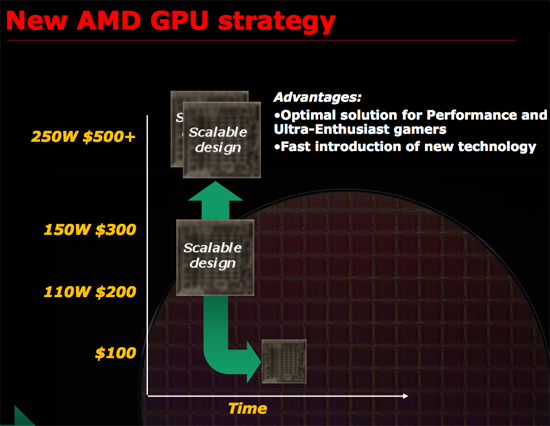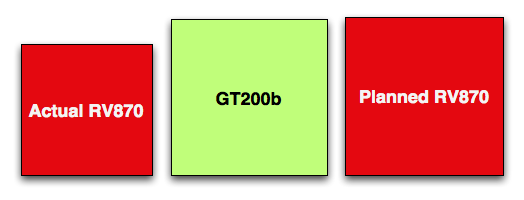The RV870 Story: AMD Showing up to the Fight
by Anand Lal Shimpi on February 14, 2010 12:00 AM EST- Posted in
- GPUs
The Other Train - Building a Huge RV870
While the Radeon HD 5800 series just launched last September, discussions of what the GPUs would be started back in 2006.
Going into the fall of 2007 ATI had a rough outline of what the Evergreen family was going to look like. ATI was pretty well aware of DirectX 11 and Microsoft’s schedule for Windows 7. They didn’t know the exact day it would come out, but ATI knew when to prepare for. This was going to be another one of those market bulges that they had to align themselves with. Evergreen had to be ready by Q3 2009, but what would it look like?
Carrell wanted another RV770. He believed in the design he proposed earlier, he wanted something svelte and affordable. The problem, as I mentioned earlier, was RV770 had no credibility internally. This was 2007, RV770 didn’t hit until a year later and even up to the first day reviews went live there were skeptics within ATI.
Marketing didn’t like the idea of building another RV770. No one in the press liked R600 and ATI was coming under serious fire. It didn’t help that AMD had just acquired ATI and the CPU business was struggling as well. Someone had to start making money. Ultimately, marketing didn’t want to be on the hook two generations in a row for not being at the absolute top.
It’s difficult to put PR spin on why you’re not the fastest, especially in a market that traditionally rewards the kingpin. Marketing didn’t want another RV770, they wanted an NVIDIA killer. At the time, no one knew that the 770 would be an NVIDIA killer. They thought they just needed to build something huge.

AMD's new GPU strategy...but only for the RV770
From August through November 2007, Carrell Killebrew came very close to quitting. The argument to build a huge RV870 because NVIDIA was going to build a huge competitor infuriated him. It was the exact thinking he fought so hard against just a year earlier with the RV770. One sign of a great leader is someone who genuinely believes in himself. Carrell believed his RV770 strategy was right. And everyone else was trying to get him to admit he was wrong, before the RV770 ever saw the light of day.
Even Rick Bergman, a supporter of Carrell’s in the 770 design discussions, agreed that it might make sense to build something a bit more aggressive with 870. It might not be such a bad idea for ATI to pop their heads up every now and then. Surprise NVIDIA with RV670, 770 and then build a huge chip with 870.
While today we know that the smaller die strategy worked, ATI was actually doing the sensible thing by not making another RV770. If you’re already taking a huge risk, is there any sense in taking another one? Or do you hedge your bets? Doing the former is considered juvenile, the latter - levelheaded.
Carrell didn’t buy into it. But his options were limited. He could either quit, or shut up and let the chips fall where they may.

A comparison of die sizes - to scale.
What resulted was sort of a lame compromise. The final PRS was left without a die size spec. Carrell agreed to make the RV870 at least 2x the performance of what they were expecting to get out of the RV770. I call it a lame compromise because engineering took that as a green light to build a big chip. They were ready to build something at least 20mm on a side, probably 22mm after feature creep.










132 Comments
View All Comments
Stas - Sunday, February 14, 2010 - link
Awesome. Thanks!Adul - Sunday, February 14, 2010 - link
Really helps pass the time at work today. :) Keep it up.Btw when can we expect to see the new site launch?
aapocketz - Sunday, February 14, 2010 - link
[quote]I was convinced that ATI had embraced a new, refocused approach to GPU design, only to learn that they nearly threw out all of the learnings with the RV870. [/quote]It sounds like they have had some successes trying different techniques, but without stability in their production process it is hard to repeat success. I understand that they require constant innovation to stay competitive, but throwing out whole processes seems chaotic to me. I would like them to refine and improve successful processes rather than toss everything every time a new business guru is in charge.
Also half of their effort was all about openness and collaboration. The opening up of the PRS document so that "everyone was involved in the process" seems to clash with the hyper-secret groups where "AMD has since incorporated much of Carrell’s brand of information compartmentalization into how it handled other upcoming features." This seems like a recipe for disaster to me. Which is it, broad openness, collaboration and consesus; or secret teams that have no idea what the other teams are doing?
SuperGee - Sunday, February 14, 2010 - link
The story told us that they didn't know it will become a succes because these desision where made before RV770 release. So doing the high risk choice again. Wasn't a nobrainer. But a risky choice. We know that it turn out good now.mckirkus - Sunday, February 14, 2010 - link
It's kind of funny that you're not yet running one of these companies yet Anand.One of the reasons I check this site on a daily basis is because you also seem to also get the business side of the equation. It's downright refreshing to see someone bridging that gap. You pretty much saved the Vertex from self destruction. I'd like to see what interesting things you could build us if you put your mind to it.
deputc26 - Sunday, February 14, 2010 - link
Articles like these are what differentiate AnandTech from all the other sites out there. AnandTech goes from being one of the best review sites out there to something special.Beyond excellent, thanks Anand.
rickyv - Sunday, February 14, 2010 - link
As a loyal follower of your website for the past 15 years, I also felt that I just had to register and compliment you on an excellent article.With the rapid advancement of technology, it is very easy just to get caught up in the PR and marketing hype or focus only on the numbers game. We often lose sight of the fact that it is teams of dedicated people who make this possible. You have always had the ability to bring out the "human" side to this. I have not seen this on any other site nor in printed form (that is not an unashamedly PR marketing exercise).
Thanks for staying true to your roots by giving honest opinions of the technology that you review. The latest releases are not necessarily always the greatest (as much as the marketing departments would like us to believe :-) )
krish123 - Sunday, February 14, 2010 - link
After i read the article, I found that "Engine is running well and firing on all the cylinders", It can create better products in the future, I can trust and buy ATI products, hope they deliver better products in the future for my upgrade."Kudos to Anand for the excellent article".
By the way graphics card is a product, not just hardware, it has to work in tandem with the software, its better ATI put some more effort on the driver/software side and fix all the issues.
Krish
smartalec - Sunday, February 14, 2010 - link
"When companies like AMD and NVIDIA do a product the engineers don't know all of the answers, and the knowledge they do have isn't binary - it's probability, it's weight, it's guesses. Sometimes they guess right, and sometimes they guess very wrong. The best they can do is to all weigh in with their individual experiences and together come up with the best group of guesses to implement."I'm afraid this is how all engineering works. Project managers think that engineers can predict the future. That we know exactly how much time it'll take, and how much risk a given feature will bring.
We don't. There's a lot of educated guesses. Sometimes we're pleasantly surprised that what we thought was a tough problem wasn't. Sometimes we're the bearer of bad news-- something we assumed would be trivial wasn't.
My most frustrating issues aren't technical at all. I ask for 2000 hours, and are given 1000. Or are given 2 engineers instead of 3, and told-- figure out a way to get it done anyway, without impacting schedule.
Great article Anand.
mckirkus - Sunday, February 14, 2010 - link
Any decent project manager (I do software) reviews the risks up front with the engineers before building the project plan / timeline.The fact that most project managers don't really understand the products they manage is the rule not the exception. The problem is that great engineers don't always make great PMs. Having a good tech lead helps.